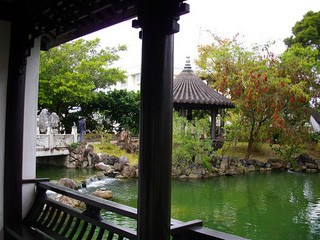Fuzhou
- Other Names: 閩 (Mǐn), 榕城 (Róngchéng)
- Chinese/Japanese: 福州 (Fúzhōu; Fukushuu)
Fuzhou is the capital of China's Fujian province, and is a major port facing the East China Sea. Located only a short distance from Taipei and from Okinawa, Fuzhou was the chief center of Ryukyuan activity in China, and the chief intermediary point for Ryukyuan officials traveling between Okinawa and Beijing.
History
The city is located on the northern bank of the lower reaches of the Min River, and has been an active mercantile port since the Tang Dynasty. As the chief city in the region of Minnan culture and language, the city is sometimes known as Mǐn. It is also sometimes known as Róngchéng, or Banyan City, for its many banyan trees.[1]
Japanese activity in Fuzhou increased especially in the 14th century, when increased pirate activity in the waters around Korea caused many ships to abandon their Ningpo-via-Hakata route and to seek a more southerly port in China.[2]
A shibosi (Maritime Trade Office) was established in Fuzhou in 1470, being moved there from Quanzhou, marking the city as one of China's chief centers of maritime trade. The shibosi in Fuzhou was shut down, however, in 1523, along with that in Ningpo, following the Ningpo Incident in which Japanese ships competing over trade with China attacked one another within the port of Ningpo. Formal Sino-Japanese relations were severed, and for a time the shibosi in Guangzhou was the only such office remaining in operation. Ryukyuan activity in Fuzhou continued unabated, however.
Following the end of the Opium War, under the 1842 Treaty of Nanking, Fuzhou became one of five Chinese ports officially opened to Western trade. British and other foreign (Western) settlements grew up in certain parts of the city, and Fuzhou quickly became a major center of modern shipbuilding and naval (military) activity. This caused it to be a target of attack during the Sino-French War (1884-1885), but the city, its trade, and its foreign population, recovered. In 1916, 806 Japanese residents, operating 153 Japanese businesses in the city, represented the largest ethnic minority, while 265 British residents represented the second largest.
Relations with Ryûkyû
When Fuzhou became the home of the shibosi (office supervising maritime trade) in 1470, it also became the designated port for Ryukyuans entering China on official business (chiefly, related to the paying of tribute). The Liuqiu-guan (the headquarters provided by the city for Ryukyuan visitors) is believed, however, to have already been in operation at that time, having been first established around 1430-1440. Related sites included the Huitong-guan, a section within the governmental areas of the city reserved for visiting foreign dignitaries, and the Guozijian, where Ryukyuan students and scholars studied.[3]
Roughly 200,000 Ryukyuans are believed to have traveled to China over the course of the Ming and Qing Dynasties (the vast majority of them entering via Fuzhou), while a total of 320,000 are believed to have journeyed to Southeast Asian polities during the Ming Dynasty alone.[4] This included officials and students, as well as merchants and, on occasion, castaways who, for logistical and legal reasons often passed through Fuzhou after making shore or being found/rescued.
Fuzhou was also the chief waypoint by which Chinese officials departed China on missions to Ryûkyû, and the site of meetings between Ryukyuan and Chinese officials, as well as other Ryûkyû-related Chinese official business. Ryukyuan official reports to the Chinese authorities took place here, alongside the paying of tribute, as well as official requests for investiture, and Ryukyuan meetings with Chinese investiture envoys prior to the departure of the latter for Ryûkyû. The local Fuzhou authorities were responsible, of course, not only for housing and otherwise accommodating Ryukyuan visitors at the Ryûkyû-kan, but for doing the same for these Chinese officials passing through Fuzhou on their way between Beijing and Ryûkyû.
Tributary relations between Qing Dynasty China and the Ryûkyû Kingdom ended with the abolition of the latter in the 1870s, and for a brief period Fuzhou became a center of Ryukyuan activism as a small group of prominent Ryukyuan figures petitioned (though ultimately unsuccessfully) the Chinese government to do something to oppose the Japanese takeover of the Ryukyus. A group of authorized merchants known as qiú shāng (球商) held an official monopoly on commerce with Ryukyuan missions and traders; they bought Ryukyuan goods and sold them on Chinese markets, bought Chinese local goods to sell to the Ryukyuans, and served to an extent as interpreters.[5]
Trade between southern China and Okinawa prefecture enjoyed a brief revival following the Sino-Japanese War, when such activity was promoted by the Japanese government in order to boost the prefecture's economy. Maruichi shoten, a trading company supported by investments from the former Ryukyuan royal family, established a branch office in Fuzhou, trading Chinese tea and other manufactured/processed goods for kombu, textiles, and canned goods from Osaka. Thus trade between Fuzhou and Okinawa enjoyed a brief revival, but ended once again as Sino-Japanese relations turned hostile in the 1930s.
References
- Watanabe Miki. "Chûgoku ni okeru Ryûkyû shiseki 日本における琉球史跡." (personal webpage).
- ↑ Akamine Mamoru, Lina Terrell (trans.), Robert Huey (ed.), The Ryukyu Kingdom: Cornerstone of East Asia, University of Hawaii Press (2017), 113.
- ↑ Uezato Takashi. "The Formation of the Port City of Naha in Ryukyu and the World of Maritime Asia: From the Perspective of a Japanese Network." Acta Asiatica 95 (2008). p58.
- ↑ "The Rekidai Hoan: An Introduction to Documents of the Ryukyu Kingdom." Editorial Office of Rekidai Hoan, Okinawa Archives, Okinawa Prefectural Board of Education (trans.). Kyoto Review of Southeast Asia 3 (March 2003). 15 pages.
- ↑ Takara Kurayoshi 高良倉吉. Hosetsu to sankô mondai - Ryûkyû ôkoku-shi no kadai 「補説と参考問題」『琉球王国史の課題』. Hirugi-sha ひるぎ社, 1989.
- ↑ Schottenhammer, Angela. “Empire and Periphery? The Qing Empire’s Relations with Japan and the Ryūkyūs (1644–c. 1800), a Comparison.” The Medieval History Journal 16, no. 1 (April 1, 2013): 181.
